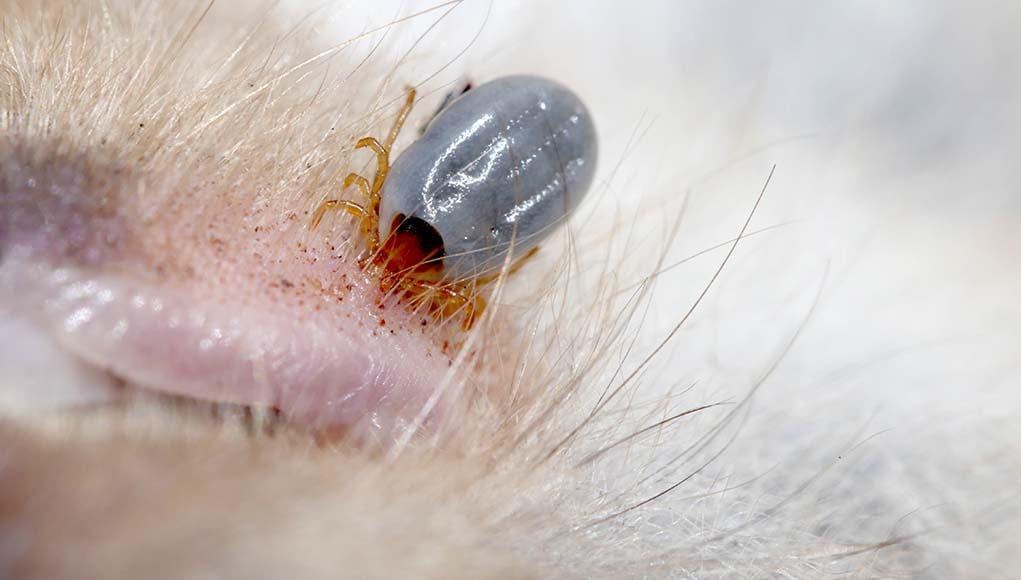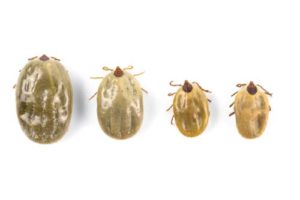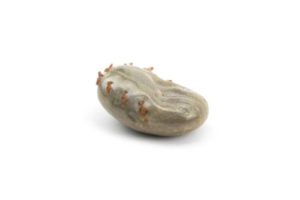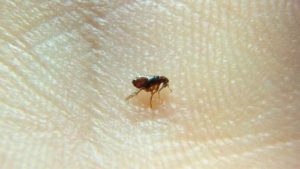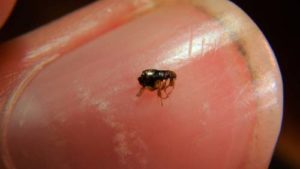We give our dogs preventative medications every month to keep fleas and ticks at bay, but we are also protecting them against a whole host of illnesses that these critters could carry. Let's take a closer look at some of these diseases and what you should know about all of them.
ALSO READ: The Ultimate Dog Fleas and Ticks Survival Guide
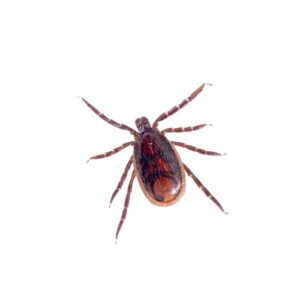
Lyme Disease
Carried By: Brown Deer Tick
Prevalence: Common
Contractible By Humans: Yes (via tick but not via infected dogs)
What Is It?
Lyme disease is caused by a spirochete bacterium called Borrelia. Borrelia is carried by the brown deer tick and when the tick feeds on its host (you or your dog!), they transmit these bacteria through the blood. Lyme disease is generally not transmitted to a host if an infected tick is attached for less than 24 to 48 hours.
Where Is It Found?
In the U.S., Lyme disease is most commonly found in the Northeast, the Upper Midwest, and the Pacific coast.
Symptoms
Symptoms of Lyme disease in dogs typically appear between two and five months after a bite from an infected tick. These symptoms include:
- Fever
- Limping
- Lameness
- Enlarged lymph nodes
- Lethargy
Diagnosis and Treatment
A diagnosis of Lyme disease in dogs can be made using a blood test; however, if the bite from the infected tick was recent, a blood test may not yet test positive. Once tested positive, your veterinarian will begin your dog on a course of antibiotics which can last anywhere between 14 and 30 days. If left untreated, Lyme disease can cause kidney failure and can be fatal.
Prevention
There is currently an annual vaccination available for dogs in areas where Lyme disease is prevalent. While the vaccination is not 100% effective in preventing Lyme disease, it is believed to make it less severe when it is not completely effective.
Flea and tick preventatives and regularly checking for and removal of ticks is also important in prevention.
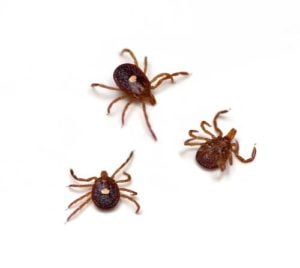
Canine Ehrlichiosis
Carried By: Brown Dog Tick and Lone Star Tick
Prevalence: Unknown (this is an emerging disease)
Contractible By Humans: Yes (via tick but not via infected dogs)
What Is It?
Canine Ehrlichiosis is caused by an organism known as the rickettsial organism. There are multiple species of the rickettsial organism that can cause canine Ehrlichiosis including Ehrlichia canis, Anaplasma platys (formerly Ehrlichia platys), Anaplasma phagocytophila (formerly Ehrlichia equi) and Ehrlichia ewingii. Most often, dogs are infected by the Ehrlichia canis.
The rickettsial organism is transmitted through the blood via the bite of an infected brown deer tick or lone star tick.
Where Is It Found?
Canine Ehrlichiosis is most commonly found in the southeastern and southwestern states as well as California and New Jersey.
Symptoms
Symptoms of canine Ehrlichiosis in dogs are categorized into three categories – acute (an early stage disease), sub-clinical (where there are no outward signs of the illness), and clinical or chronic stage (a long-standing infection in the dog).
Acute symptoms are seen in early disease and usually last two to four weeks:
- Swollen lymph nodes
- Weight loss
- Fever
- Respiratory distress
- Bleeding disorders
- Neurological disturbances
Sub-clinical symptoms which are seen in infected dogs with no outward signs of infection:
- Prolonged bleeding from blood draw site during testing
- High levels of globulin in the blood
- Low platelet levels in the blood
Chronic or clinical symptoms which are seen in a long-term infection which may or may not develop from the sub-clinical phase of infection depending on whether your dog is able to eliminate the organism:
- Lameness
- Episodic bleeding
- Anemia
- Vision or eye problems
- Swelling of the limbs
- Neurological problems
- Bone marrow failure
Diagnosis and Treatment
Like Lyme disease, it can be difficult to test a dog in the early stages of infection of canine Ehrlichiosis. In most instances, it takes between two to three weeks for an infected dog to test positive for infection. Your vet will use a positive test and physical symptoms to make a diagnosis.
Treatment for canine Ehrlichiosis is usually a six weeks (or more) course of antibiotics. For dogs that have a more advanced infection causing bleeding problems, a blood transfusion may be necessary.
Prevention
Flea and tick preventatives and the treatment of your property for ticks is the best method of preventing canine Ehrlichiosis.
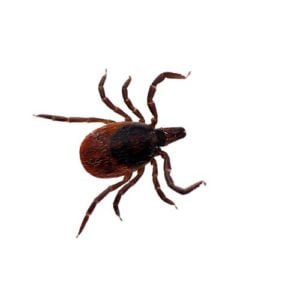
Anaplasmosis
Carried By: Black-Legged Deer Tick and Deer Tick
Prevalence: Common
Contractible By Humans: Yes (via tick but not via infected dogs)
What Is It?
Anaplasmosis in dogs is caused by one of two varieties of bacteria called A. phagocytophilum and A. platys. These bacteria are carried by the black-legged deer tick and the deer tick respectively. Anaplasmosis is transmitted to your dog when an infected tick feeds on them and passes the bacteria through the blood. Veterinarians believe that an infected tick must be attached to your dog for approximately 24 hours to transmit Anaplasmosis to your dog.
Where Is It Found?
Anaplasmosis is most often found in New England, the North Central United States, and Northern California.
Symptoms
Symptoms of Anaplasmosis in dogs depends on the infecting bacteria. Dogs infected by A. phagocytophilum often present with the following symptoms which tend to last for between one to seven days:
- Fever
- Appetite loss
- Lameness
- Joint pain
- Lethargy
- Coughing
- Diarrhea
- Vomiting
- Respiratory distress
Dogs infected by A. platys often present with the following symptoms:
- Slow reduction in platelet count
- Easy bruising
- Nosebleeds
- Other bleeding problems
Diagnosis and Treatment
A diagnosis of Anaplasmosis can be made using one of a handful of blood tests or through a microscopic blood sample analysis. Anaplasmosis is treated through antibiotics and while symptoms may begin to resolve in a week, a 30-day course of treatment may be needed.
Prevention
Flea and tick preventatives and the treatment of your property for ticks is the best method of preventing Anaplasmosis.
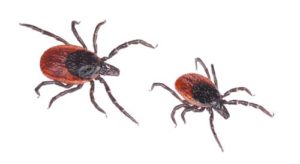
Rocky Mountain Spotted Fever
Carried By: American Dog Tick, Rocky Mountain Wood Tick, Brown Deer Tick
Prevalence: Common
Contractible By Humans: Yes (via tick but not via infected dogs)
What Is It?
Rocky Mountain spotted fever is caused by an organism called Rickettsia rickettsia which is carried by infected American dog ticks, Rocky Mountain Wood ticks, and brown deer ticks. The organism is transferred through the blood, however, veterinarians believe that a tick must be attached to a host for at least 5 hours to spread the disease.
Where Is It Found?
Rocky Mountain spotted fever is most commonly seen in the east, Midwest, and plains regions of the U.S.
Symptoms
Symptoms of Rocky Mountain spotted fever include:
- Fever
- Decreased appetite
- Joint pain
- Depression
- Vomiting
- Lameness
- Diarrhea
- Heart abnormalities
- Liver damage
- Kidney failure
- Pneumonia
- Neurological symptoms
Diagnosis and Treatment
A diagnosis of Rocky Mountain spotted fever is made through a blood test that takes place over a couple of weeks, however, if your veterinarian sees signs of the disease they will often begin treatment even before a positive test result.
Treatment for Rocky Mountain spotted fever is a course of antibiotics that can last between 2 to 3 weeks.
Prevention
There is currently no preventative treatment for RMSF, so flea and tick preventatives and the treatment of your property for ticks is the best method of preventing it in your home.

Babesiosis (Piroplasmosis)
Carried By: Black-Legged Tick
Prevalence: Common
Contractible By Humans: Yes (via tick but not via infected dogs)
What Is It?
Babesiosis is caused by a protozoan called Babesia. There are multiple types of Babesia protozoa that can spread Babesiosis (this is why both humans and dogs can get the disease, but humans cannot get the disease from their dogs). When an infected tick feeds on its host, the Babesia protozoa is transmitted to the host through the blood.
Where Is It Found?
Babesiosis is a disease that is found worldwide, but in the U.S. it is more prevalent in the southern U.S.
Symptoms
Symptoms of Babesiosis in dogs typically appear after a two week incubation period. These symptoms include:
- Fever
- Weakness
- Depression
- Dark urine
- Weakness
- Pale mucous membranes
- Swollen lymph nodes
- Yellow or orange skin
- Weight loss
- Enlarged abdomen
- Enlarged spleen
Diagnosis and Treatment
A diagnosis of Babesiosis is made using one of a variety of blood tests as well as by taking physical symptoms into consideration. It can take up to ten days for a positive test result after infection from the Babesiosis.
There are multiple treatment options for Babesiosis and the treatment of choice depends on the type of protozoa causing the infection and treatment availability. Treatment may include a course of Clindamycin antibiotics or the traditional imidocarb dipropionate treatment for large Babesiosis spp. infection.
Prevention
There is currently no preventative treatment for Babesiosis, so flea and tick preventatives and the treatment of your property for ticks is the best method of preventing it in your home.
Canine Bartonellosis
Carried By: Fleas and Ticks
Prevalence: Not highly common in dogs
Contractible By Humans: Yes
What Is It?
Canine Bartonellosis is caused by a bacterium called the Bartonella bacterium. The Bartonella bacteria is carried by fleas, sand flies, lice, and ticks and transmitted through the blood after being bitten by an infected flea, fly, lice, or tick.
There are still many unknowns about canine Bartonellosis, but it is known that this disease can be transmitted between animals and humans.
Where Is It Found?
Canine Bartonellosis is found throughout the U.S. but cases tend to be more prevalent during the fall and winter months.
Symptoms
Symptoms of canine Bartonellosis in dogs are wide-ranging and not always observable in infected dogs. These symptoms include:
- Fever
- Lameness
- Liver enlargement
- Enlarged spleen
- Eye inflammation
- Heart inflammation
- Diarrhea
- Vomiting
- Seizures
- Brain inflammation
- Lymph node inflammation
- Cough
- Nasal irritation and discharge
Diagnosis and Treatment
A diagnosis of Bartonellosis in dogs is made through a blood test and urinalysis.
There is no definitive treatment protocol for Bartonellosis in dogs, however, treatment does involve a course of antibiotics of approximately 4 to 6 weeks. Which antibiotics are best for your dog’s infection will be determined by your vet.
Prevention
There is currently no preventative treatment for Bartonellosis, so flea and tick preventatives and the treatment of your property for ticks is the best method of preventing it in your home.
Hepatozoonosis
Carried By: Gulf Coast Ticks and Adult Brown Dog Ticks
Prevalence: Not highly common in the U.S.
Contractible By Humans: No
What Is It?
Hepatozoonosis in dogs is caused by the Hepatozoon canis (carried by the Gulf Coast tick) and Hepatozoon americanum protozoans (carried by the brown dog tick). The latter of the two is the most commonly seen protozoa in the U.S. The Hepatozoon protozoa is carried by Gulf Coast ticks and brown dog ticks. A tick becomes infected with the disease when they feed on an infected dog. Your dog becomes infected with the disease when they ingest an infected tick.
Where Is It Found?
Hepatozoonosis is most commonly found in the Southern and Southeastern United States.
Symptoms
Dogs with Hepatozoonosis americanum are most symptomatic. These dogs show symptoms that include:
- Fever
- Decreased appetite
- Weight Loss
- Enlarged lymph nodes
- Lethargy
- Discharge from eyes and nose
- Muscle pain and weakness
- Reluctance to move
These symptoms may relapse and remit but without treatment, Hepatozoonosis americanum can cause damage to the kidneys and blood vessels and cause death within a year.
Dogs with Hepatozoonosis canis are generally asymptomatic unless they have a large number of protozoans. If this is the case, symptoms may be observed and include:
- Fever
- Lethargy
- Enlarged spleen
- Low red blood cell count
- Weight Loss
Left untreated, infection with Hepatozoonosis canis can also be life-threatening.
Diagnosis and Treatment
A diagnosis of Hepatozoonosis is made by running a blood panel which may show low red blood cell count, high white blood cell count, elevated liver enzymes, increased blood protein levels, and increased enzymes related to muscle inflammation.
Dogs infected with Hepatozoonosis americanum can never be completely cured but their illness can be managed using trimethoprim-sulfa, clindamycin, and pyrimethamine. When symptoms of the disease are no longer observable, dogs will be treated with decoquinate for a minimum of two years but even after stopping decoquinate, symptoms can return and retreatment is necessary.
Dogs infected with Hepatozoonosis canis are treated with one to two injections of imidocarb and they may also receive oral antibiotics (doxycycline). Hepatozoonosis can be cured.
Prevention
There is currently no preventative treatment for Hepatozoonosis, so flea and tick preventatives and the treatment of your property for ticks is the best method of preventing it in your home.
Tularemia
Carried By: Fleas and Ticks
Prevalence: Rare
Contractible By Humans: Yes
What Is It?
Tularemia is also referred to as “Rabbit Fever” and is quite rare in dogs as they are fairly resistant to the disease.
Tularemia in dogs is caused by a bacterium called Francisella Tularemia. These bacteria are carried by fleas and ticks and can be transmitted if an infected insect bites your dog or is ingested. Tularemia can also be transmitted by drinking contaminated water, through infected soil, inhalation, or by eating an animal that carries the infection.
Where Is It Found?
Tularemia is found throughout the U.S. but it is most commonly found in Arkansas and Missouri.
Symptoms
Symptoms of Tularemia in dogs include:
- Fever
- Dehydration
- Decreased appetite
- Enlarged lymph nodes
- Lethargy
- Tender abdomen
- Enlarged liver
- Enlarged spleen
- White spots on the tongue
- Jaundice of the skin or eyes
Diagnosis and Treatment
A diagnosis of Tularemia can be difficult but it relies on you providing a history of your dog’s recent activities, a physical exam and a full blood panel. A traditional blood panel may not reveal a complete diagnosis, however, in which case, a culture of your dog’s blood will need to be sent out for specialty testing.
Treatment for Tularemia includes a course of antibiotics that will last for around 10 to 21 days. With early treatment, Tularemia can be resolved, however, if the infection goes untreated for a period of time it has a very poor prognosis.
Prevention
There is currently no available vaccination for Tularemia, so flea and tick preventatives and the treatment of your property for fleas and ticks, avoidance of dead animals, and restricting dogs from hunting activity in areas where Tularemia is active are the best methods of preventing it in your dog.
Tick Paralysis
Carried By: Deer Tick, Dog Tick, Rocky Mtn. Wood Tick, Lone Star Tick
Prevalence: Rare
Contractible By Humans: Yes (via tick but not via infected dogs)
What Is It?
Tick paralysis is caused by a neurotoxin found in the saliva of a full or gravid female tick of various species. The neurotoxin is transmitted to the tick’s host during feeding.
Where Is It Found?
Tick paralysis is found throughout the U.S. but is most frequent in the Rocky Mountain states, the Pacific Northwest and parts of the South.
Symptoms
Symptoms of tick paralysis in dogs typically appear between 3 to 9 days of the tick attaching to the host. These symptoms include:
- Fatigue
- Muscle pain
- Leg numbness
- Growing paralysis from the lower to upper limbs
Diagnosis and Treatment
A diagnosis of tick paralysis is based on symptoms and a full examination of your dog for an engorged tick. Since the neurotoxin causing symptoms is produced by the salivary glands of the tick, once the tick has been removed, symptoms begin to resolve. Without removal of the offending tick, however, tick paralysis can be fatal.
Prevention
There is currently no preventative treatment for tick paralysis, so flea and tick preventatives and the treatment of your property for ticks is the best method of preventing it in your home. You should also regularly check your dog over for ticks and remove any attached ticks immediately.
Flea Allergy Dermatitis (FAD)
Carried By: Fleas
Prevalence: Common
Contractible By Humans: Yes (via fleas but not via infected dogs)
What Is It?
Flea allergy dermatitis is caused by an allergic reaction to the saliva of fleas rather than to an illness carried by the flea itself. When fleas feed on a host, they expose the host skin to saliva and in some dogs (and people) this saliva causes an allergic reaction. Symptoms of flea allergy dermatitis can occur immediately or can occur between 14 and 48 hours after a flea bite.
Where Is It Found?
Flea allergy dermatitis can be found anywhere that fleas are found since it depends on the immune reaction of the individual that has been bitten.
Symptoms
Symptoms of flea allergy dermatitis in dogs include:
- Itching
- Restlessness
- Discomfort
- Skin irritation
- Hair loss
- Skin infection
Diagnosis and Treatment
A diagnosis of flea allergy dermatitis can be made by the presence of fleas or flea excrement combined with visible symptoms, and intradermal testing.
Treatment of flea allergy dermatitis involves removing the fleas and topically treating your pet’s symptoms to ease their discomfort. It’s also crucial that your home is treated for fleas and flea eggs to eliminate a further infestation.
Prevention
Prevention of flea allergy dermatitis involves the regular application of flea and tick preventatives.
Tapeworms
Carried By: Fleas
Prevalence: Common
Contractible By Humans: Yes (via infected fleas)
What Is It?
Tapeworm infestation occurs when your dog eats a flea that has eaten a tapeworm egg. The hatched tapeworm then attaches to your dog’s small intestinal wall and feeds off nutrients as it grows and reproduces.
Where Is It Found?
Canine tapeworm can be found throughout the United States.
Symptoms
Symptoms of a tapeworm infestation usually occur once the tapeworm reaches adulthood and begins to shed egg packets in your dog’s waste. At this time you may notice small yellowish specks in your dog's poop that looks similar to rice, you may also see these specks around your dog’s bottom or even small worms! When this happens your dog may begin to scoot their bottom on the floor because of itching.
If your dog has a heavier infestation of tapeworm, you may notice that they are losing weight. Additionally, if an adult tapeworm makes its way up to your dog’s stomach it may induce vomiting. When this happens it isn’t uncommon to see a worm in your dog’s vomit as well.
Diagnosis and Treatment
A diagnosis of tapeworm in dogs is usually made when your vet inspects your dog’s hind end and find evidence of infection or through a fecal exam that reveals worm segments or eggs in your dog’s poop.
Treatment for tapeworm infestation involves treatment with a dewormer that will dissolve the worms. There are various dewormers available and your vet will determine which is the best one for your dog.
Prevention
Prevention of tapeworm infestation involves the regular application of flea and tick preventatives as well as regular fecal exams at your vet to keep your dog parasite free!
Flea-Bite Anemia
Carried By: Fleas
Prevalence: Common in dogs with a heavy flea infestation
Contractible By Humans: No
What Is It?
Flea-bite anemia happens when a dog is infested with so many fleas that they lose a large amount of blood. This blood loss isn’t just a problem because your dog is losing valuable iron, but they are also losing blood volume needed for their basic bodily systems to function. Most often, flea-bite anemia is seen in sickly, elderly, or very young dogs who are less able to withstand rapid blood loss.
Where Is It Found?
Flea-bite anemia can be found anywhere there are fleas which means throughout the U.S.
Symptoms
Symptoms of flea-bite anemia include:
- Weakness
- Rapid breathing
- Lethargy
If the flea infestation is left untreated a dog with flea-bite anemia will succumb to blood loss.
Diagnosis and Treatment
A diagnosis of flea-bite anemia is made through observation of physical symptoms and visible evidence of flea infestation. Blood tests will reveal anemia, though flea infestation will likely be so severe that your vet can make a diagnosis before test results return.
Treatment for flea-bite anemia involves treatment for the flea infestation as well as supportive care for your dog as they recover (which may include a blood transfusion). It is also crucial that your home is treated to eliminate any flea infestation or flea eggs that could reinfect your dog.
Prevention
Prevention of flea-bite anemia is dependent on the regular application of flea and tick preventatives.
Flea-Borne Typhus
Carried By: Fleas
Prevalence: Unknown
Contractible By Humans: Yes (via infected fleas)
What Is It?
Flea-borne typhus is also called murine typhus or endemic typhus is caused by a bacteria called Rickettsia typhi. The bacteria is carried by infected fleas. Fleas get the bacteria from feeding on an infected animal and when that infected flea feeds on a host (your dog), they transmit the Rickettsia typhi. bacteria to them.
Where Is It Found?
Flea-borne typhus is most prevalent in California, Hawaii, and Texas.
Symptoms
Symptoms of flea-borne typhus in dogs generally begin two weeks after being bitten by an infected flea. Not all dogs show symptoms, but for those who do these symptoms include:
- Fever
- Chills
- Muscle pain
- Cough
- Appetite loss
- Nausea
- Vomiting
Diagnosis and Treatment
Your vet will be able to make a diagnosis of flea-borne typhus using a blood test as well as any knowledge of a current flea-borne typhus outbreak in the area.
Treatment for dogs with symptomatic flea-borne typhus includes a course of doxycycline for 10 to 21 days along with the eradication of the flea infestation in your dog and in your home.
Prevention
Prevention of flea-bite anemia is dependent on the regular application of flea and tick preventatives.
Bubonic Plague
Carried By: Fleas
Prevalence: Rare
Contractible By Humans: Yes (possible but unlikely)
What Is It?
The bubonic plague is caused by a parasite called Yersinia pestis. This parasite is carried by infected fleas or infected rodents and is transmitted to your dog when they are bitten by a flea, bitten by an infected rodent, or consuming an infected rodent.
Where Is It Found?
Bubonic plague is rare in dogs because they have a fairly high resistance to the plague parasite. When the plague does occur it is most often in rural areas and tends to be more prevalent in northern New Mexico, northern Arizona, southern Colorado, California, southern Oregon, and far western Nevada.
Symptoms
Symptoms of bubonic plague in dogs usually appear between two and seven days after being infected. These symptoms include:
- Fever
- Swollen lymph nodes
- Depression
- Inflammation
- Vomiting
- Diarrhea
- Dehydration
- Loss of appetite
If the infection becomes severe, weight loss will become noticeable and a coma may follow.
Diagnosis and Treatment
To make a diagnosis of bubonic plague, your vet will run blood tests as well as urinalysis, and a complete physical exam. Since the plague is a rare occurrence, a number of tests will be required to rule out other causes of illness and to confirm plague infection.
 Once diagnosed, your dog will be kept in isolation while they receive supportive care and a full course of antibiotics. It’s also crucial to treat any initial flea infestation in your dog and your home.
Once diagnosed, your dog will be kept in isolation while they receive supportive care and a full course of antibiotics. It’s also crucial to treat any initial flea infestation in your dog and your home.
Treatment of the plague must be initiated as soon as possible and treatment should be comprehensive because a failure to catch it early or to treat it properly often results in death.
Prevention
Prevention of the plague is dependent on the regular application of flea and tick preventatives and elimination and prevention of rodent problems.
READ NEXT: Top 50 Best Flea Treatments for Dogs


